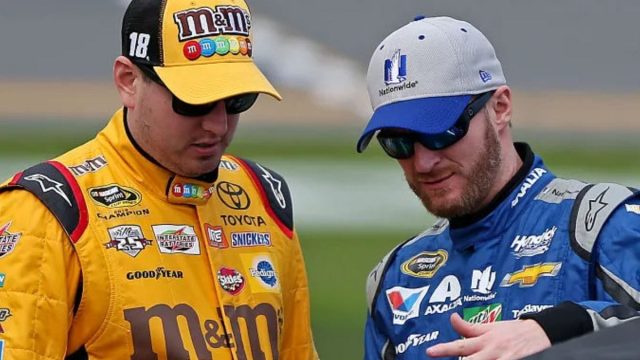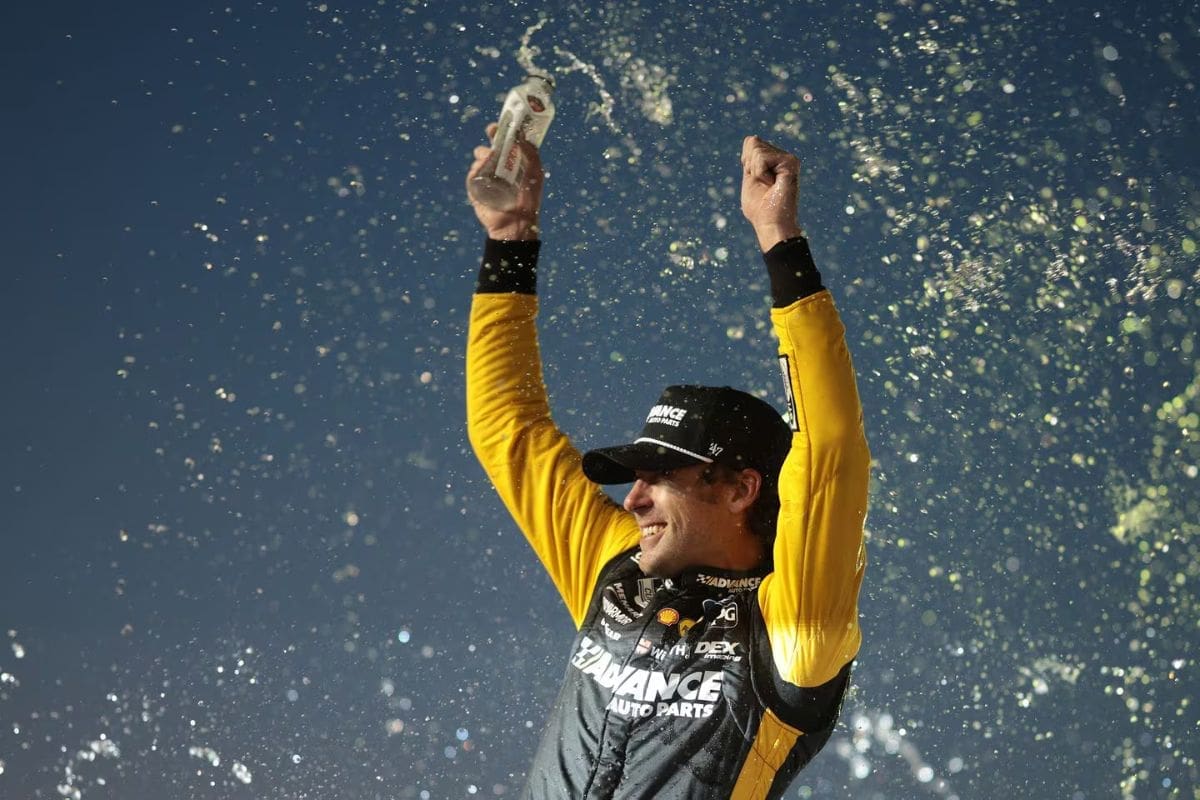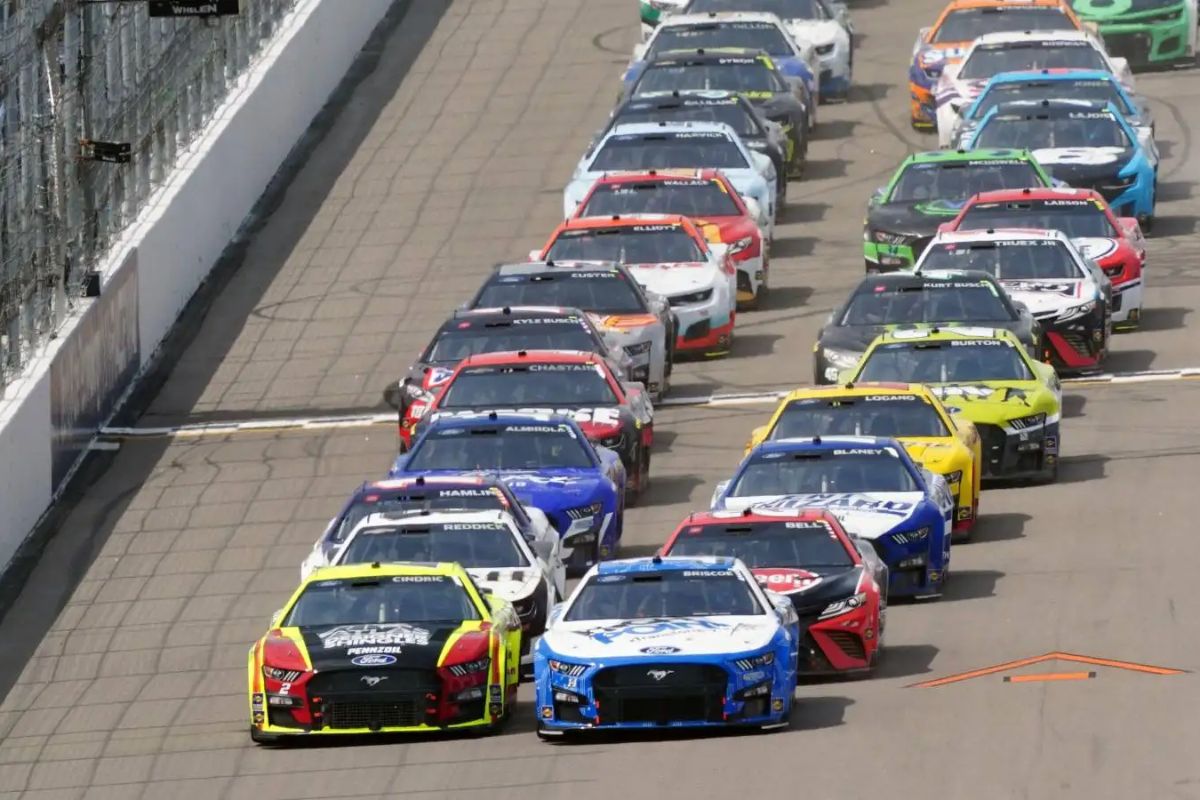Dale Jr. Blames Kyle Busch for Ryan Blaney’s Loss: Dale Earnhardt Jr. has publicly attributed considerable responsibility to Kyle Busch for undermining Ryan Blaney‘s prospects at the Indianapolis race, particularly following Busch’s collision with Denny Hamlin in Turn 3 that led to a crucial caution. This incident demonstrates the intricate interplay of driver actions and race outcomes, raising questions about the extent to which one competitor can influence another’s performance. As the NASCAR community reflects on this controversial moment, it prompts a broader examination of competitive ethics and strategy within the sport. What implications might this have for future races and driver relationships?
Key Highlights
- Dale Earnhardt Jr. attributed Ryan Blaney’s race misfortune to Kyle Busch’s actions in Turn 3 that triggered a crucial caution.
- Busch’s collision with Denny Hamlin significantly altered the race’s dynamics and positions for several drivers, including Blaney.
- Ryan Blaney expressed frustration that his opportunity for victory was compromised by the chaos resulting from Busch’s actions.
- Dale Jr. emphasized the need for accountability among drivers, highlighting how individual actions can dramatically influence race outcomes.
Ryan Blaney’s Discontent and the Race Outcome
Ryan Blaney’s frustration with the outcome of the Brickyard 400 highlights not only his personal disappointment but also raises questions about the influence of race management decisions on competitive fairness in NASCAR. His palpable anger following the race stemmed from a belief that Kyle Larson was unjustly positioned to win, an assertion that reflects broader concerns regarding the integrity of race outcomes.
Blaney’s discontent is representative of a driver who has worked tirelessly to achieve success, only to have it potentially undermined by factors beyond his control. In the final moments of the race, a series of events appeared to unfold in Larson’s favor, leading to speculation about the role of NASCAR’s officiating in shaping the race’s finale.
Blaney’s assertion that the circumstances felt ‘scripted‘ emphasizes a sentiment among competitors that race management decisions can tilt the scales of competition. The integrity of NASCAR hinges on the perception of fairness, and when a driver feels that race officials have played a decisive role in determining the outcome, it raises critical questions about the sport’s governance.
The implications of this incident extend beyond Blaney’s individual grievance; they touch on a core issue within NASCAR regarding how race management strategies can impact not only individual outcomes but also the comprehensive competitive landscape.
Dale Earnhardt Jr.’s Take on Kyle Busch’s Role
In the wake of the controversial finish at the Brickyard 400, Dale Earnhardt Jr. pointedly attributed the dramatic outcome to Kyle Busch’s involvement in the multi-car crash that altered the race’s path. Busch’s actions in Turn 3 not only initiated the caution but also set off a chain reaction that ultimately favored Kyle Larson, allowing him to capitalize on the situation. Earnhardt Jr. articulated a perspective that, while unpopular among some fans, emphasizes the influence of individual drivers on race dynamics.
“Kyle Busch was the caution that led to this, so for pointing fingers, I think it’s Kyle Busch.”– jr
Key points from Earnhardt Jr.’s analysis include:
- Caution’s Origin: Busch’s low entry into Turn 3 led to a collision with Denny Hamlin, causing a crucial caution.
- Impact on Strategy: The ensuing caution reshuffled the field, altering pit strategies and race positions considerably.
- Blaney’s Disadvantage: Ryan Blaney, who had been in a strong position, lost his advantage when Larson was allowed to restart ahead.
Ryan Blaney’s Reaction and Disappointment
Following the controversial finish at the Brickyard 400, Blaney expressed his frustration and disappointment over the circumstances that led to his missed opportunity for victory. His remarks emphasized a deep sense of injustice, as he articulated the absurdity of promoting the third-place finisher in scenarios where the leader encounters difficulties. “That’s not right,” he asserted, highlighting the dissonance between race strategy and the resulting outcomes dictated by luck.
“With this, you’re promoting the third-place guy before the second place guy if the leader has problems. That’s not right,” he said. “It’s dumb luck, right, of where Brad ran out and stuff like this. At this race track where the bottom (lane) is preferred. I don’t know. I’m just upset. That’s a heartbreaker. We did everything right today. I mean, was in prime position to win and just didn’t work out for us. Just got unlucky.” – Blaney
Blaney’s perspective shows a critical flaw in racing protocols, where the actions of drivers beyond the top competitors can inadvertently skew the legitimacy of competitive standings. His palpable anger was directed not just at the race’s outcome but also at the mechanics of luck that played a decisive role in his fate.
His disappointment is further magnified by the sense that they executed their plan flawlessly throughout the race, only to be thwarted by unforeseen factors. Describing the experience as a ‘heartbreaker,’ Blaney encapsulated the emotional toll of coming so close to victory yet falling short.
Ryan Preece’s Impact on the Race
The unexpected spin of Ryan Preece during the extra overtime reshaped the dynamics of the race, ultimately influencing the outcome and sparking debate among competitors and analysts alike. Preece’s incident in Turn 2 not only disrupted the flow of the race but also raised questions about decision-making under stress, particularly regarding NASCAR’s caution protocol.
“Ryan Preece gets spun out by Chase Elliot unintentional. Preece runs out of gas coming out off turn 2. I was wondering how all that went down because I was so ready to blame Preece for all of this nonsense. We’ll you know we gave Cindric a hard time for creating all that Fiasco at Nashville. Its only fair we sort of make sure we. You know Preece is the suspect here that we have to question.” -jr
Preece’s actions can be analyzed through several critical dimensions:
- Strategic Decisions: Choosing to remain on the track despite fuel concerns proved detrimental, as Preece ran out of gas, leading to his spin.
- Timing of Caution: NASCAR’s choice to delay the caution until after the leaders passed the white flag impacted the race’s final result, preventing further competition.
- Influence on Race Leaders: The spin allowed Kyle Larson to secure a victory, effectively sidelining potential challengers by ending the race under yellow rather than green.
NASCAR’s Explanation and Future Prospects
NASCAR’s recent clarification regarding the caution call during the Indianapolis race sheds light on the organization’s commitment to allowing natural race endings while steering through the complexities of safety and competition. Elton Sawyer, NASCAR’s Vice President of Competition, articulated the rationale behind the decision to refrain from issuing a caution on the final lap, emphasizing a desire for the race to conclude authentically. This approach highlights NASCAR’s dedication to preserving the integrity of the competition, even when faced with challenging circumstances.
“Obviously we’d like for it to play out naturally. We want our teams to race to the checkered flag. We did everything we possibly could. We kept an eye on the #41. He got turned around. He was really giving a solid effort and once he came to a stop and we could tell that he had, I think, a flat left-rear tire he wasn’t going to move. We’d already taken the white, we just couldn’t run by there again. So it was unfortunate, but it was the right call.” – Sawyer
The decision not to call a caution despite the #41 car’s predicament demonstrates a balancing act between ensuring driver safety and honoring the competitive spirit of racing. Sawyer’s remarks reveal that the officials were closely monitoring the situation and only acted when absolutely necessary, reinforcing the notion that NASCAR prioritizes a natural finish over artificial interventions. The hesitance to deploy the caution flag indicates a broader philosophical commitment to maintaining the excitement and unpredictability that fans crave.
Looking ahead, NASCAR’s challenge will be to navigate these situations with increasing scrutiny from teams, drivers, and fans similarly. As the series resumes in Richmond after a two-week hiatus, the organization must continue to refine its protocols to uphold both safety and competitive integrity.
News in Brief: Dale Jr. Blames Kyle Busch for Ryan Blaney’s Loss
The incident at the Indianapolis race serves as a poignant reminder of the intricate interplay between individual driver actions and general race outcomes.
Kyle Busch’s collision with Denny Hamlin not only precipitated a caution but also altered the competitive landscape for Ryan Blaney, ultimately undermining his chances for victory.
This situation exemplifies the unpredictable nature of motorsport, where a single moment can greatly impact the course of a race and the aspirations of competing drivers.
ALSO READ: Dale Earnhardt Jr. Stands Up for Kyle Busch Amidst Historic NASCAR Challenge



